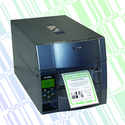Perfect printing
30 November 2010Mark Beauchamp, European Marketing Manager for Citizen Systems Europe, explores how packaging companies have taken advantage of the opportunities presented by the latest generation of labelling systems.
Labelling systems, both on and off-line, are used widely in packaging and process operations, providing an efficient method of branding products and of adding key information for end users. In each case, however, labelling equipment is often expected to operate reliably for extended periods of time without maintenance and in conditions that are far from ideal, with high temperatures or levels of contamination.
As a result, it is vital to consider a number of critical factors when specifying a printing solution for packaging applications.
For example, it is necessary to consider the information to be printed onto the labels, as the degree of printing definition required can differ dramatically from a product needing a simple ingredients list to one requiring a barcode, for instance. Barcodes continue to provide an efficient method of identifying and tracking products and components manufactured on factory production lines. However, in order to work effectively, they must be printed clearly and consistently.
The number of labels required and the frequency with which they need to be applied also needs to be taken into account. Conventional desktop label printers are typically unable to cope with larger volumes, and the all-plastics construction of many of these printers makes them unsuitable for a factory environment. In addition, these conventional machines are prone to errors, and are bulky and difficult to install. On the other end of the scale, some companies opt for heavy duty printers that are over specified for the task in hand, increasing costs unnecessarily.
Another factor that needs careful consideration is the potential risk of contamination within the operating environment. In particular, dust and particulate matter from factory processes can often enter the printer casing, reducing print quality and eventually leading to printer failures or returned goods due to poorly printed information and barcodes that cannot be scanned.
To overcome these problems and to meet the requirements of most packaging applications, leading printer manufacturers, such as Citizen Systems Europe, have been consistently working to evolve their offering. This has led to the development of a new generation of barcode and label printers that are designed to print high volumes of labels quickly and accurately.
Cutting edge materials
In particular, the latest models incorporate cutting edge materials, such as high performance plastics, with single-piece housings and lightweight yet tough media handling units. The printers are more robust, and the overall strength of each unit can be derived from both the plastics cases and metal chassis. As a result, the number of parts has been reduced significantly.
Additionally, all major components, including the power supply, Ethernet connection and wireless LAN, are housed inside the printer casing, making it safer and more compact.
To ensure productivity levels are optimised, the printers include a number of innovative features. For example, a user friendly, vertically opening clamshell design, like that of Citizen’s CLP 621 and 631, makes it easy to access the inside of the printer for media and ribbon loading. Many new machines also feature easy access side loading for ribbons, which enables the ribbon to be changed ‘in seconds’.
The sophisticated print mechanisms on the latest printers also allow a wide and diverse range of media to be handled. In particular, it is now possible to print labels onto both conventional paper media and specialised media, including advanced polyester labels with antimicrobial coatings and metallic labels that are typically used for serial number tagging. Similarly, the machines can accommodate labels that are long lasting and capable of resisting aggressive solvents over a far greater range of label widths than has previously been possible, including narrow labels less than 2.5cm in width.
As well as choosing printers that are simple to use, another way to reduce human error and streamline the printing process is to introduce an inline validation system. With in-line validation an alarm is automatically raised if print quality drops, due to, for example, contamination entering a printer’s casing and obstructing the print head. Likewise, if the printhead needs replacing, staff are made aware sooner rather than later, allowing a production line to keep running.
Effective labelling is vital to the success of virtually all packaging businesses, allowing products to be recognised and traced as they pass through every stage of the supply chain. With the introduction of the latest generation of barcode and label printers, companies can now find a solution that can meet all of their specific requirements in terms of functionality, while also increasing the efficiency of their operation, cutting costs, boosting productivity and ultimately enhancing profitability.
One of the latest labellers from Citizen Systems Europe, the cls 700, which is said to be robust and easy to use. Citizen Systems


